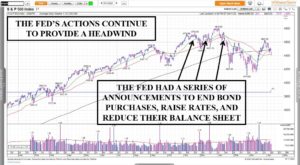There’s a reason the late, great Marty Zweig came up with the phrase “Don’t Fight the Fed.” They’re not the only thing that controls the market, but they are very influential. The market moves for many reasons, but the two main factors are earnings and interest rates. Monitoring the Fed’s actions is important because they affect interest rates, especially short-term rates and overall liquidity.
For example, since April 2020, the Fed started pumping tons of liquidity into the system. They not only kept interest rates near-zero, but they also made more Treasury purchases in the six weeks following the pandemic than they did in the nine years combined between 2009-2018. They continued with $120 billion in monthly bond purchases.
In mid-December 2021, I turned cautious on the market, mainly because the Fed started talking about taking all this accommodation away. In a series of announcements between early December 2021 and mid-January 2022, the Fed discussed ending their bond purchases, raising interest rates, and decreasing their balance sheet. Since then, their hawkish actions have provided a serious headwind for the market.
Chart is provided by MarketSmith
My conclusion is that the market is unlikely to see sustained upside as long as the Fed is raising rates and removing liquidity from the system. What will it take for the Fed to turn dovish or at least pause their rate hikes? Of course, no one knows, but I think they will keep going until something breaks. By breaks, I mean the S&P 500 correcting 20%, valuations correcting to a reasonable level, a problem in the bond market, and/or credit spreads widening too much.
For example, in the fall of 2018, the Fed was already raising rates and Fed Chair Powell said he would continue to raise 3 or 4 more times in the upcoming year. The market proceeded to drop 10%. In their December 19th meeting, they forecasted more hikes, and discussed reducing their balance sheet (sound familiar?). The market dropped another 10% until Powell eventually pivoted on January 4th and said they would be “patient” on interest rate hikes.
So, what changed from December 19, 2018, to January 4, 2019? The S&P 500 completed a 20% correction. You might think this is a little conspiracy theory, but last Wednesday, former N.Y. Fed President William Dudley said the Fed “will have to inflict more losses on stock and bond investors than it has so far.” My interpretation is that Fed will continue to raise rates and reduce their balance sheet as long as the stock and bond markets allow them to. Considering we are approximately 6% off the highs, it feels like they have plenty of room to work with.
Please keep in mind that just because the Fed is providing a difficult headwind for the market, it doesn’t mean that we have to go straight down. In other words, when sentiment gets too negative, we will continue to see countertrend rallies to keep the bears in check. For example, the recent rally in the second half of March had nothing to do with the Fed. It was mainly because sentiment was getting too negative and also due to quarter-end seasonality/portfolio adjustments. Also, there are still many stocks acting well, especially in commodity-related sectors. In a stronger market, we would see a broader range of stocks acting consistently well, but there are still decent opportunities out there.
From here, your strategy should depend on your overall investment objectives and if you are a trader or investor. For traders, here are a few suggestions: 1) Don’t overthink the macro picture. Keep things simple and follow price. 2) Since we are likely to see higher volatility over the next few months, use lighter than normal positions to help prevent from getting tossed around. 3) Get strong entry points. Use the 21-day EMA as your guide and do NOT chase extended stocks. 4) Try to expose yourself to the strongest stocks. 5) Manage risk and cut losses based on your timeframe. 6) Use index ETFs if you want. You don’t have to ONLY trade individual stocks. 7) If you are on margin and/or stuck in many of the old leaders that are down 50-70% or more, consider cutting some losses. It would make sense to have some cash on hand for when better opportunities present themselves later this year. Again, all of these decisions should be based on your own investment objectives.
If I can offer any words of encouragement: Things can change quickly. Stay defensive but don’t get overly bearish. The market is a discounting mechanism and tends to trade on what will happen six to nine months from now. In other words, although the Fed will remain hawkish and inflation is likely to be around for a while, the market will eventually factor this in and turn around. There will be tremendous opportunities in growth stocks later this year, but you just have to be patient until conditions improve.
I can be reached at: jfahmy@zorcapital.com
Disclaimer: This information is issued solely for informational and educational purposes and does not constitute an offer to sell or a solicitation of an offer to buy securities. None of the information contained on this site constitutes a recommendation that any particular security, portfolio of securities, transaction, or investment strategy is suitable for any specific person. From time to time, the content creator or its affiliates may hold positions or other interests in securities mentioned on this site. The stocks presented are not to be considered a recommendation to buy any stock. This material does not take into account your particular investment objectives. Investors should consult their own financial or investment adviser before trading or acting upon any information provided. Past performance is not indicative of future results.


